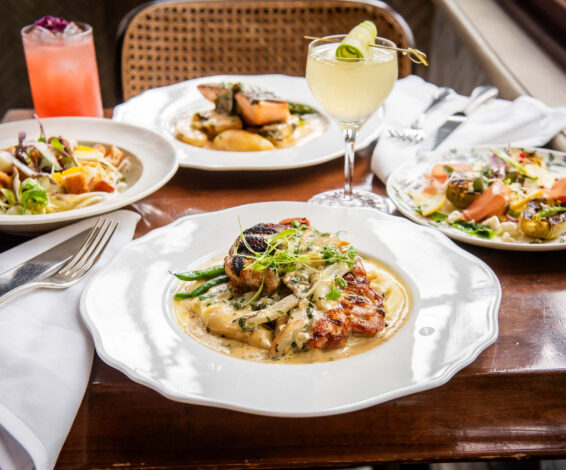
Executive Chef
John Horne
As District Executive Chef at Oliver & Bonacini Hospitality, John Horne not only leads the culinary vision for Auberge du Pommier, La Plume, Maison Selby, and Biff’s Bistro but also plays a pivotal role in overseeing O&B’s corporate culinary operations on a national scale. His cuisine is marked by refined flavours, a focus on seasonal ingredients, and striking presentation.
After completing the Niagara College Culinary Management program, John honed his skills in London, England, working alongside Chef Ian Wood at Almeida. His time at Michelin-starred restaurants such as L’Escargot, The Square, and The Orrery sharpened his classic French techniques. He later spent seven years as Senior Sous Chef at Auberge du Pommier, under the mentorship of Chef Jason Bangerter, where he further developed his expertise in French cuisine. John then returned to Europe, expanding his culinary knowledge at Crillon le Brave.
In 2010, John took on the role of Chef de Cuisine at Canoe, where he embraced the bounty of Canadian ingredients. Inspired by his international experience, he embarked on a mission to elevate Canadian cuisine, showcasing local heritage through its rich array of ingredients.
John’s passion for wild game and foraged ingredients is deeply rooted in his upbringing. As an avid outdoorsman, he grew up hunting and foraging with his family, a tradition that continues to inspire his approach to Canadian food. John has appeared in an episode of In The Weeds, which followed his family farm’s foraging adventures, as well as the food and farming documentary Before The Plate, which traced 10 Ontario ingredients back to their source.
Under John’s exceptional leadership, Oliver & Bonacini continues to flourish, setting new standards of culinary excellence and hospitality. His innovative approach to cuisine, coupled with his unwavering dedication to quality and creativity, has propelled O&B’s restaurants to the forefront of the culinary scene. Outside of the kitchen, John finds solace and joy in spending time with his wife and two children, cherishing moments of togetherness amidst his busy schedule.
A History of St. James Town’s Cultural Centrepiece
1883
The mansion was designed by acclaimed architect David Roberts Jr., who had extensive connections to Toronto’s prominent Gooderham family (the cofounders of Gooderham and Worts Distillery, now known as the Distillery District). Roberts Jr. was also responsible for designing Toronto’s Flatiron Building.
1885
Henry Folwell Gooderham sold the house to his youngest brother, Charles Horace Gooderham, who resided there until his death in 1904.
1910–1912
The prestigious girls’ private school Branksome Hall—founded in 1903—relocated from its original home on Bloor Street East to the Charles Horace Gooderham House.
Margaret Eaton, of the Eaton family, attended the school at this location. She went on to become Commanding Officer of the Canadian Women’s Auxiliary Corp. and the highest-ranking female officer during World War II.
1912–1913
The C.H. Gooderham House became home to the Selby Hotel, originally founded as a private “hostel” that catered to elderly female clientele (when it wasn’t hosting Canadian and British officers during WWII), and was viewed as one of Toronto’s cultural focal points. The Selby became a public hotel in 1920.
1923
Internationally renowned author Ernest Hemingway was one of many creative heavyweights who stayed at the Selby Hotel. During his brief career as a foreign correspondent at the Toronto Star, he occupied two adjoining rooms: room 301 and the “Gooderham Suite.”
40’s-50’s
The Selby grew in popularity among sports fans and athletes—including hockey players Turk Broda and Rocket Richard, wrestler Bulldog Brower, and boxer Whipper Billy Watson.
1950’s
The Men’s Beverage Room was introduced and frequented by notable personalities including (at some point) William Shatner.
The Selby also operated a licensed bar named the Skyway Lounge.
Aug 1976
The C.H. Gooderham House was listed on the City of Toronto Inventory of Heritage Properties.
1981
After their lease ended at the original Charles St. address—and only half a year after the bathhouse raids by Toronto police in February 1981—Boots, one of Toronto’s most esteemed gay dance clubs, re-opened in the lower level of 592 Sherbourne St.
Boots was one of many Toronto bars that represented social change and a safe space to foster connections within the gay community.
The expansiveness of the lower level allowed the owners to open a lounge space named Bud’s, with more pub-like seating, inside what used to be a men’s draft hall.
May 1989
The mansion was designated under the Ontario Heritage Act.
1990’s
The Selby reportedly underwent over $500,000 of repairs. The owners replaced the damaged rooftop with slate, built an imposing front desk, and reconstructed the wrought-iron fencing in front of the building to match the original.
1994–1995
Boots and Bud’s underwent a substantial transformation into Boots Warehouse, Toronto’s largest gay dance club in the day, and the Kurbash, a sleaze bar with a maze and a shower.
1997
The mansion was purchased by new owners who turned the Selby into a Howard Johnson.
2000
Although the new owners continued to run Boots Warehouse for a few years following the purchase, the beloved club bid farewell just before Pride. Boots remains in Toronto’s memory as a revolutionary, one-of-a-kind relic of LGBTQ liberation.
2000’s
The most recent rendition of 592 Sherbourne took the form of The Clarion Hotel & Suites Selby, which closed in 2014.

















